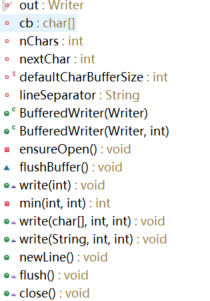
java io BufferedWriter源码分析
发布于2020-11-19 20:48 阅读(793) 评论(0) 点赞(11) 收藏(2)
目录
字段out,cb,nChars,nextChar,defaultCharBufferSize,lineSeparator,两个构造函数
方法ensureOpen,flushBuffer,write,min
2个write方法,方法newLine,flush,close
简介
- package java.io;
-
-
- /**
- * 将文本写入字符输出流,缓冲字符,以便有效地编写单个字符、数组和字符串。
- *
- * <p> 可以指定缓冲区大小,也可以接受默认大小。
- * 缺省值对于大多数用途来说已经足够大了。
- *
- * <p>提供了一个newLine()方法,它使用平台自己的线分隔符概念,由系统属性line.separator定义。
- * 不是所有平台都使用换行符('\n')来结束行。
- * 因此,最好调用这个方法来终止每个输出行,直接生成换行符。
- *
- * <p>一般来说,写入器立即将其输出发送到底层字符流或字节流。
- * 除非需要立刻输出,否则建议将BufferedWriter包裹在任何可能
- * 需要write()操作的写入器周围,比如FileWriters和OutputStreamWriters。例如,
- *
- * <pre>
- * PrintWriter out
- * = new PrintWriter(new BufferedWriter(new FileWriter("foo.out")));
- * </pre>
- *
- * 将缓冲PrintWriter的输出到文件中。
- * 如果没有缓冲,每次调用print()方法都会导致字符被转换成字节,然后立即写入文件,这可能非常低效。
- *
- * @see PrintWriter
- * @see FileWriter
- * @see OutputStreamWriter
- * @see java.nio.file.Files#newBufferedWriter
- *
- * @author Mark Reinhold
- * @since JDK1.1
- */
-
- public class BufferedWriter extends Writer

字段out,cb,nChars,nextChar,defaultCharBufferSize,lineSeparator,两个构造函数
- // 内部有一个Writer,类似于装饰器模式
- private Writer out;
-
- // 缓存数组cb
- private char cb[];
- // cb的大小和下一个写入的index
- private int nChars, nextChar;
-
- // 默认缓存大小,8192个char
- private static int defaultCharBufferSize = 8192;
-
- /**
- * 行分隔符字符串。
- * 这是在流创建时的line.separator的值。
- */
- private String lineSeparator;
-
- /**
- * 创建使用默认大小的输出缓冲区的缓冲字符输出流。
- *
- * @param out A Writer
- */
- public BufferedWriter(Writer out) {
- this(out, defaultCharBufferSize);
- }
-
- /**
- * 创建一个新的缓冲字符输出流,该流使用给定大小的输出缓冲区。
- *
- * @param out A Writer
- * @param sz Output-buffer size, a positive integer
- *
- * @exception IllegalArgumentException If {@code sz <= 0}
- */
- public BufferedWriter(Writer out, int sz) {
- // 以out作为lock
- super(out);
- if (sz <= 0)
- throw new IllegalArgumentException("Buffer size <= 0");
- // 设置out和sz大小的cb
- this.out = out;
- cb = new char[sz];
- // nChars为cb的长度,nextChar为0
- nChars = sz;
- nextChar = 0;
-
- // line.separator的值
- lineSeparator = java.security.AccessController.doPrivileged(
- new sun.security.action.GetPropertyAction("line.separator"));
- }
方法ensureOpen,flushBuffer,write,min
- /** 检查以确保流没有被关闭 */
- private void ensureOpen() throws IOException {
- if (out == null)
- throw new IOException("Stream closed");
- }
-
- /**
- * 将输出缓冲区刷新到基础字符流,而不刷新流本身。
- * 这个方法是非私有的,所以它可以被PrintStream调用。
- */
- void flushBuffer() throws IOException {
- synchronized (lock) {
- ensureOpen();
- if (nextChar == 0)
- return;
- // out中写入cb[0,nextChar]
- out.write(cb, 0, nextChar);
- // 指针重新设置为0
- nextChar = 0;
- }
- }
-
- /**
- * 写入单个字符
- *
- * @exception IOException If an I/O error occurs
- */
- public void write(int c) throws IOException {
- synchronized (lock) {
- ensureOpen();
- // 如果缓冲区溢出,将缓冲区刷入底层writer
- if (nextChar >= nChars)
- flushBuffer();
- // nextChar处设置c,然后nextChar++
- cb[nextChar++] = (char) c;
- }
- }
-
- /**
- * 我们自己的min方法,如果我们已经用完文件描述符,试图打印堆栈跟踪,避免加载java.lang.Math。
- */
- private int min(int a, int b) {
- if (a < b) return a;
- return b;
- }
2个write方法,方法newLine,flush,close
- /**
- * 写入字符数组的一部分。
- *
- * <p> 通常,该方法将给定数组中的字符存储到该流的缓冲区中,根据需要将缓冲区刷新到底层流。
- * 但是,如果请求的长度至少与缓冲区一样大,则此方法将刷新缓冲区并直接将字符写入底层流。
- * 因此冗余的BufferedWriter不会复制不必要的数据。
- *
- * @param cbuf A character array
- * @param off Offset from which to start reading characters
- * @param len Number of characters to write
- *
- * @exception IOException If an I/O error occurs
- */
- public void write(char cbuf[], int off, int len) throws IOException {
- synchronized (lock) {
- ensureOpen();
- if ((off < 0) || (off > cbuf.length) || (len < 0) ||
- ((off + len) > cbuf.length) || ((off + len) < 0)) {
- throw new IndexOutOfBoundsException();
- } else if (len == 0) {
- return;
- }
-
- if (len >= nChars) {
- /* 如果请求长度超过输出缓冲区的大小,则刷新缓冲区,然后直接写入数据。
- 以这种方式缓冲的流将无害地倾泻。
- */
- flushBuffer();
- out.write(cbuf, off, len);
- return;
- }
-
- int b = off, t = off + len;
- // 当len>0,进行循环
- while (b < t) {
- // 每次复制min(nChars-nextChar,len)个元素到cb
- int d = min(nChars - nextChar, t - b);
- System.arraycopy(cbuf, b, cb, nextChar, d);
- b += d;
- nextChar += d;
- if (nextChar >= nChars)
- flushBuffer();
- }
- }
- }
-
- /**
- * 写入字符串的一部分。
- *
- * <p> 如果len参数的值为负,则不写入字符。
- * 这与父类中write(String,int,int)方法的说明相反,
- * 它要求抛出一个IndexOutOfBoundsException。
- *
- * @param s String to be written
- * @param off Offset from which to start reading characters
- * @param len Number of characters to be written
- *
- * @exception IOException If an I/O error occurs
- */
- public void write(String s, int off, int len) throws IOException {
- synchronized (lock) {
- ensureOpen();
-
- int b = off, t = off + len;
- while (b < t) {
- // 每次复制min(nChars-nextChar,len)个元素到cb
- int d = min(nChars - nextChar, t - b);
- s.getChars(b, b + d, cb, nextChar);
- b += d;
- nextChar += d;
- if (nextChar >= nChars)
- flushBuffer();
- }
- }
- }
-
- /**
- * 写入行分隔符。行分隔符字符串由系统属性line.separator行定义。
- * ,不一定是单一的newline ('\n')字符。
- *
- * @exception IOException If an I/O error occurs
- */
- public void newLine() throws IOException {
- write(lineSeparator);
- }
-
- /**
- * 刷新流
- *
- * @exception IOException If an I/O error occurs
- */
- public void flush() throws IOException {
- synchronized (lock) {
- // 把缓存写入out,然后底层的out进行flush
- flushBuffer();
- out.flush();
- }
- }
-
- @SuppressWarnings("try")
- public void close() throws IOException {
- synchronized (lock) {
- if (out == null) {
- return;
- }
- // 缓存写入out后,设置out,cb为null
- try (Writer w = out) {
- flushBuffer();
- } finally {
- out = null;
- cb = null;
- }
- }
- }
原文链接:https://blog.csdn.net/xushiyu1996818/article/details/109719885
所属网站分类: 技术文章 > 博客
作者:我爱java
链接:http://www.javaheidong.com/blog/article/957/69c4f009f9cdc603098c/
来源:java黑洞网
任何形式的转载都请注明出处,如有侵权 一经发现 必将追究其法律责任
昵称:
评论内容:(最多支持255个字符)
---无人问津也好,技不如人也罢,你都要试着安静下来,去做自己该做的事,而不是让内心的烦躁、焦虑,坏掉你本来就不多的热情和定力